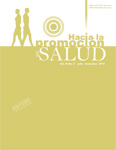Authors
Abstract
Objective: to describe the applications of the five most used scales in the world for measuring quality of life related to the health of adolescents, by region and study population, 1963-2013. Methods: Systematic review of scientific literature published in the past five decades. A research protocol was applied with search terms, inclusion and exclusion criteria, quality assessment of articles and information extraction; this was carried out by two investigators to confirm reproducibility. The analysis was based on absolute and relative frequencies in SPSS 21.0. Results: the search identified 3,789 studies of which 548 met the research protocol and included 573,648 teenagers. The regions with the highest number of publications were America (44.5%) and Europe (37.8%). Most investigations corresponded to sick people. Among the instruments analyzed the most frequent was PedsQL (47.4%). In studies using PedsQL the largest proportion was for endocrine and metabolic diseases (15%), KIDSCREEN was the most used scale in healthy population (24%), CHQ in caregivers (30%), MOSSF in intervention studies (23%) and KINDL in validation studies (22%). Conclusion: the research allowed generating a usage profile of the most common tools in the assessment of quality of life related to adolescents' health, which emphasizes that PedsQL predominates in diseased populations, KIDSCREEN in healthy population and in CHQ in the parent s' version.
References
2. Petersen-Ewert C, Erhart M, Ravens-Sieberer U. Assessing health-related quality of life in European children and adolescents. Neurosci Biobehav Rev. 2011; 35(8): 1752-1756.
3. Solans M, Pane S, Estrada MD, Serra-Sutton V, Berra S, Herdman M, et al. Health-Related Quality of Life Measurement in Children and Adolescents: A Systematic Review of Generic and Disease-Specific Instruments. Value Health. 2008; 11(4): 742-764.
4. Clarke SA, Eiser C. The measurement of health-related quality of life (QOL) in paediatric clinical trials: a systematic review. Health Qual Life Outcomes. 2004; 2(1): 66.
5. Rotta AH, Januária A, Borges M, Alves de Britto JA, Queiroz de Oliveira C, Nunes MC. Qualidade de vida de crianças e adolescentes: uma revisão bibliográfica. Cienc. Saúde coletiva. 2011; 16(7): 3197-3206.
6. Rajmil L, Herdman M, Fernandez de Sanmamed MJ, Detmar S, Bruil J, Ravens-Sieberer U, et al. Generic health-related quality of life instruments in children and adolescents: a qualitative analysis of content. J Adolesc Health. 2004; 34(1): 37-45.
7. Rajmil L, Roizen M, Psy AU, Hidalgo-Rasmussen C, Fernández G, Dapueto JJ. Health-Related Quality of Life Measurement in Children and Adolescents in Ibero-American Countries, 2000 to 2010. Value Health. 2012; 15(2): 312-322.
8. Higuita-Gutiérrez LF, Cardona-Arias JA. Calidad de vida relacionada con la salud en adolescentes: revisión sistemática de las investigaciones publicadas en el periodo 1970-2013. Caracterización de las investigaciones sobre la calidad de vida relacionada con la salud del adolescente: Revisión sistemática: 1970-2013. MÉD UIS. 2015; 28(1): 23-30.
9. PedsQL TM. Pediatric Quality of Life Inventory TM. [acceso diciembre de 2013]. Disponible en: http://www.pedsql.org/
10. Deutsch kidscreen.org. [acceso diciembre de 2013]. Disponible en: http://www.kidscreen.org/
11. Health Act CHQ. CHQ: Child Health Questionnaire. [acceso diciembre de 2013]. Disponible en: http://www.healthact.com/chq.php
12. Deutsch kindl.org. [acceso diciembre de 2013]. Disponible en: http://kindl.org/
13. Vilagut G, Ferrer M, Rajmil L, Rebollo P, Permanyer-Miralda G, Quintana JM, et al. The Spanish version of the Short Form 36 Health Survey: a decade of experience and new developments. Gac Sanit SESPAS. 2005; 19(2): 135-150.
14. Wallander JL, Schmitt M, Koot HM. Quality of life measurement in children and adolescents: issues, instruments, and applications. J Clin Psychol. 2001; 57(4): 571-585.
15. Soares AHR, Martins AJ, Lopes M da CB, Britto JAA de, Oliveira CQ de, Moreira MCN. Quality of life of children and adolescents: a bibliographical review. Ciênc Saúde Coletiva. 2011; 16(7): 3197-3206.
16. Detmar SB, Bruil J, Ravens-Sieberer U, Gosch A, Bisegger C, European KIDSCREEN group. The use of focus groups in the development of the KIDSCREEN HRQL questionnaire. Qual Life Res Int J. 2006; 15(8): 1345-1353.
17. Herdman M, Rajmil L, Ravens-Sieberer U, Bullinger M, Power M, Alonso J, et al. Expert consensus in the development of a European health-related quality of life measure for children and adolescents: a Delphi study. Acta Paediatr. 2002; 91(12): 1385-1390.
18. Erhart M, Hagquist C, Auquier P, Rajmil L, Power M, Ravens-Sieberer U, et al. A comparison of Raschitem-fit and Cronbach's alpha item reduction analysis for the development of a Quality of Life scale for children and adolescents. Child Care Health Dev. 2010; 36(4): 473-484.
19. Ravens-Sieberer U, Herdman M, Devine J, Otto C, Bullinger M, Rose M, et al. The European KIDSCREEN approach to measure quality of life and well-being in children: development, current application, and future advances. Qual Life Res. 2014; 23: 791-803.
20. Ellert U, Ravens-Sieberer U, Erhart M, Kurth BM. Determinants of agreement between self-reported and parent-assessed quality of life for children in Germany-results of the German Health Interview and Examination Survey for Children and Adolescents (KiGGS). Health and Quality of Life Outcomes. 2011; 9: 102.
21. Rajmil L, Rodríguez A, López-Aguilá S, Alonso J. Parent-child agreement on health-related quality of life (HRQOL): a longitudinal study. Health and Quality of Life Outcomes. 2013; 11: 101.
22. Rajmil L, Serra-Sutton V, Fernández-López JA, Berra S, Aymerich M, Cieza A, et al. The Spanish version of the German health-related quality of life questionnaire for children and adolescents: the Kindl. An Pediatría Barc Spain. 2004; 60(6): 514-521.
23. Lin XJ, Lin IM, Fan SY. Methodological issues in measuring health-related quality of life. Tzu Chi Medical Journal. 2013; 25: 8-12.
24. Snyder C, Aaronson N, Choucair A, Elliott T, Greenhalgh J, Halyard M, et al. Implementing patient-reported outcomes assessment in clinical practice: a review of the options and considerations. Qual Life Res. 2012; 21(8): 1305-1314.


 PDF (Español)
PDF (Español)
 FLIP
FLIP






















